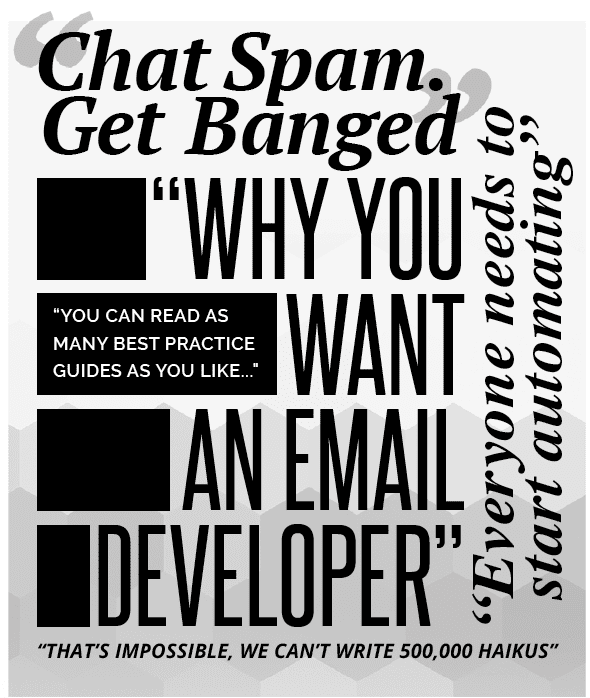How to use financial data to win over stakeholders to your email marketing strategy
 LinkedIn hosts 2.7 million+ profiles for people with 'Email Marketing' skills. Our field is growing constantly growing in what to me, is inarguably one of the most versatile and creative areas of digital marketing. Whilst there are some amazing resources, such as Litmus who write the gospel for designers and coders, we wanted to create something focused on the the challenges of the email marketing manager.
LinkedIn hosts 2.7 million+ profiles for people with 'Email Marketing' skills. Our field is growing constantly growing in what to me, is inarguably one of the most versatile and creative areas of digital marketing. Whilst there are some amazing resources, such as Litmus who write the gospel for designers and coders, we wanted to create something focused on the the challenges of the email marketing manager.
We had an itch. We spoke to a lot of people who had this itch too. We wanted to scratch it. Thus, the No BS Email Marketing guide was born.
In Edition One we hired nine Email Marketers across a range of industries. From Financial Service Tech to Retail, MMORPG to Online Gambling, we can now present to you their informed insights around problem-solving and the like.
We hope this provokes contemplation among different areas of Email Marketing and that you appreciate the diversity of commentators as well as the format.
 As a taster of the email guide, here's one of our favourite pieces aptly titled 'Chat Spam. Get Banged.' By Russell Dawson. This includes lots of practical tips on email marketing. It focuses on how to push back against colleagues who are suggesting an email is sent which could impact the list, i.e. How to place a financial cost against bad stakeholder emails, or why testing bad ideas is a good idea!
As a taster of the email guide, here's one of our favourite pieces aptly titled 'Chat Spam. Get Banged.' By Russell Dawson. This includes lots of practical tips on email marketing. It focuses on how to push back against colleagues who are suggesting an email is sent which could impact the list, i.e. How to place a financial cost against bad stakeholder emails, or why testing bad ideas is a good idea!
"Like it or not, politics comes into play in approval of which emails are sent to your audience. Rank is a determining factor in what, when and how emails get sent.
As the email expert, you’re positioning yourself as the go-to person for email advice and guidance. You won’t get to email mastery without being responsible for your programme and owning your stakeholders is a big part of that.
A lot of our effort is spent educating stakeholders about email marketing and helping interpret our email data - guiding them away from what the organisation wants to promote, to what the recipient actually needs at their stage in the purchasing lifecycle".
A simple helpful tip I’ve found in pushing back on stakeholder emails is to work out an approximate financial cost of sending bad email through the increase of unsubscribers.
To do that, you’ll need to know the value of an email address within your list.
( Email Revenue / Delivered Recipients = Value of Email Address )
Ideally, you’ll also want to know the value of different segments within your email list, such as:
- Demographics (eg. location, age, interest) Value (low, mid, high)
- Campaign (marketing, triggered, lifecycle)
If you’ve joined your RFM dots up, you’ll also have your average email Lifetime Value (LTV).
Check your average unsubscribe rate and apply the financial value against your lost recipients. How much money are you losing in unsubscribes, on average, per send?
Next time the word comes down from up high to create and send an email out that you don’t agree with, you’ll need some email marketing financials to get the power.
Send it - chances are it’ll attract a higher unsubscribe rate and a lower conversion rate
You can calculate the financial loss due to the increase in unsubscribe numbers that untargeted emails produce over your total list or campaign average.
Simplified example:
- Average value of an email address: £40 Average unsubscribes per email: 50 Loss: £40 x 50 = £2,000
- Bad email unsubscribes: 65
- Average unsubscribes per email: 50 Additional loss: (65 - 50 =) 15 x £40 = £600
How many other similar stakeholder emails have gone out this year already? Can you look back three to six months and what does that value look like combined?
You can add in acquisition costs, LTV and go further in determining which customers unsubscribed - if they were certain segments, frequent purchasers or high-value recipients. It all depends on how granular you are able to dive.
“Ah, but what if it has a significantly lower than average unsubscribe rate?”
Subject matter experts who add value to your emails are worth their weight in gold to you. “That’s strange” moments - where there’s a contrarian result you didn’t expect to happen - are valuable in finding hidden niches within your list. How can you leverage the situation? Can they be valuable to you in providing subject expertise or email marketing assets?
I can’t over emphasise the importance of regular stakeholder reporting.
It’s crucial keeping everyone above you informed of what’s going on since they’re also after facts and stats to pass on up the line. Regular stakeholder reporting builds confidence in our credibility and professionalism and, realistically, better chances of more email budget. Think of it as providing email marketing as a service.
Mentioning the financial value helps stakeholders interpret the data in a way they can understand, after all, nobody intentionally wants to be responsible for losing customers.
Why having a testing framework is a proactive approach to avoiding confrontation
Some stakeholders also wish to share the value of their wisdom and ideas in a certain way that you might nd subjective or disagree with. A common issue is legacy:“We’ve always done it this way”.
Be it resistance to personalisation or a request for an emoji-featuring subject line, you’ll need to own this and ensure that your emails are optimised for your customer’s needs.
Optimise, and your aggregated margins will come.
Determine what the most frequent suggestions are and set up a testing framework.
The best place to start is straightforward A/B subject line testing.
I set out a continuous testing loop of various emotive drivers such as; urgency, curiosity, scarcity, along with direct call to actions, personalisation and discounts to see which one can help increase my email metrics.
If a stakeholder demands a subject line be a certain way, you can inform them that you’ll be happy to include this as part of your testing programme. The best ones will pick themselves.
Incorporating their ideas as part of a larger testing plan is a proactive, professional way of sorting out who adds value and who’s just jiving. Ideally, you’re aiming for every deployed email to have some sort of testing on it.
Report back and when your results show your winning version on top for the fourth week running, they’ll soon learn to leave it with the expert - you.
Dealing with difficult stakeholders doesn’t have to be confrontational as long as you don’t mind getting it wrong sometimes too..

You can treat yourself this very moment to Edition One by clicking
here. We won't even ask for your email address, this time... We'd like to give huge thank you to our sponsors Kick Dynamic, Taxi For Email and eDatasource who supported our concept early on, enabling us to bring Edition One to life, and to you.




 As a taster of the email guide, here's one of our favourite pieces aptly titled 'Chat Spam. Get Banged.' By Russell Dawson
As a taster of the email guide, here's one of our favourite pieces aptly titled 'Chat Spam. Get Banged.' By Russell Dawson You can treat yourself this very moment to Edition One by clicking
You can treat yourself this very moment to Edition One by clicking 


